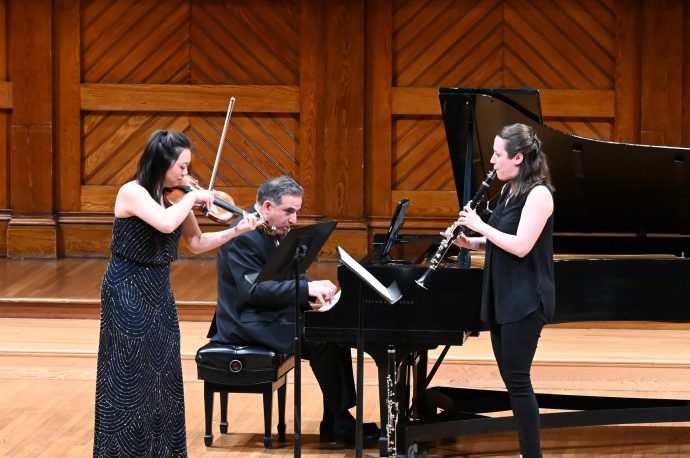Video from the September 29, 2024 concert at Sanders Theatre
Ludwig van BEETHOVEN Piano Trio No. 3 in C minor, Op. 1, No. 3 (1794-95)
Alyssa Wang, violin; Clancy Newman, cello; Max Levinson, piano
Lowell LIEBERMANN Sonata for Clarinet and Piano, Op. 138 (2021 BCMS co-commission)
Romie de Guise-Langlois, clarinet; Max Levinson, piano
Gabriel FAURÉ Piano Quartet No. 1 in C minor, Op. 15 (1876–1879; rev. 1883)
Alyssa Wang, violin; Marcus Thompson, viola; Clancy Newman, cello; Max Levinson, piano
Featured musicians
The Piano Trio No. 3 in C minor is a striking display of Beethoven’s distinct musical personality at the outset of his career and shows the young composer already pushing past conventions of tonality and form. The work opens with a stormy sonata movement, featuring an extended development and constant alternations of character.
Liebermann’s Sonata for Clarinet and Piano is “an accessible, engaging, friendly yet challenging winner.” The sonata traverses the clarinet’s registers and range of tone colors while showcasing the lyrical playing of BCMS clarinetist Romie de Guise-Langlois.
Fauré’s Piano Quartet in C minor opens with an expressive Allegro whose melodies bear a Brahmsian influence. A vibrant Scherzo features pizzicato passages for the strings, allowing the piano to shine. The largely melancholic Adagio offers glimpses of brighter memories, followed by a lively fourth movement that recalls themes heard earlier in the work.
Full program notes
It is significant that the three piano trios of Op. 1 were catalogued as such by the composer, who certainly had composed (and published) other works prior, but upon completing his studies with Johann Albrechtsberger, felt ready to call the three piano trios the beginning of his catalogue of works, therefore dismissing early works as juvenilia, or at least immature by comparison. There is much that is lost to the mists of time in terms of creation, first performances, and reception of these trios, but the C minor Piano Trio holds some distinction as an alleged catalyst (at least anecdotally) for icy tensions between Beethoven and Joseph Haydn. In 1795, Haydn had returned to Vienna after his second visit to London, and was willing to continue working with Beethoven as a student. Supposedly, upon hearing a performance of the entire Opus 1, the older composer had a favorable response, but advised against publication of No. 3, concerned that it would not garner a positive public reaction. Lewis Lockwood remarks, “That Beethoven interpreted Haydn’s reaction as jealousy fits all too well with his extreme sensitivity to criticism, certainly from Haydn.” It is not hard to imagine the youthful and impetuous Beethoven struggling with constructive criticism, nor is it difficult to surmise that Haydn would have struggled with some of Beethoven’s “sweeping originality and high emotional tension,” as Lockwood puts it. However, the three piano trios were published by subscription in the summer of 1795, so this makes the story about Haydn’s comment a bit murky, as Haydn would have had to have heard the works in 1793 before he left for London, or he heard them upon his return, just shortly before their publication.
The dedicatee of the opus, Prince Lichnowsky, was one of Beethoven’s most important patrons in Vienna, and it is likely that the trio received its premiere at one of Lichnowsky’s Friday house concerts, likely with Beethoven at the piano, violinist Ignaz Schuppanzigh and cellist Anton Kraft. Beethoven was living at Lichnowsky’s house at the time. The genre wasn’t yet popular, but certainly would have been appealing to aristocratic musicians, as evidenced by a subscription to the trios by none other than Prince Nikolaus Esterhazy.
The seven-note unison utterance that opens the Allegro con brio seems to establish C minor pathos, but the following measure destabilizes the harmony, offering a view of coming attractions, before settling into the more assertive material heard in the piano. A brief duet between piano and violin offers some respite, before aggressive homophonic declamation in all three instruments. The swirling sixteenth notes in the piano and the yearning, reaching lines in the strings seem to have all but forgotten the C minor beginnings, with a rather effervescent closing to the exposition. It is clear that Beethoven is exploring a multitude of emotions with relative thematic and motivic economy, showing a concern for both formal and psychological aspects of this first movement.
The five variations of the Andante cantabile in E-flat major are clearly defined and make solid use of the bipartite nature of the theme, which enters first in the piano, then echoed by the strings. The first variation is more ornamental and contrapuntal, relying primarily on the piano. The piano steps back initially in the second variation to provide more harmonic support as the cello and violin dance together. The piano becomes increasingly present in the second half of the variation. The animated third variation, with its running notes in the piano and pizzicato strings, provides a bit of whimsy that sets up contrast with the key change to E-flat minor in the fourth variation, with its soulful rendering of the theme in the cello. The final variation returns to E-flat major and a more perky guise with a clear sounding of the theme in the violin, supported by the cello with sparkling triplets in the piano. The coda stops the flow, as the piano recalls the theme, now reharmonized, in slow, almost solemn chords, to set the movement down gently in the major key.
The menuetto, which with its galloping and uneven phrases occupies an identity somewhere between a minuet and a scherzo, returns the work to C minor. The motivic gesture predominates until the trio is announced by a descending scale in the piano and the movement settles into a more rhetorical minuet-feel. Clearly the movement is meant as a brief divertimento in preparation for the weight of the Prestissimo finale. Opening with emphatic outlined thirds in C minor provides both a counterweight to the first movement, as well as motivic continuity. Even as the harmony shifts to E-flat major and the piano settles into oscillating accompanimental figures in the left hand, there is an underlying sense of urgency. The lyrical dolce theme is more present in the major mode, and Beethoven offers a non-committal closing of the exposition, with halting, pianissimo descending broken triads in the violin. Beethoven takes the opportunity to juxtapose several different harmonies while building upon the dolce theme with extended runs in all three instruments. The formidable coda, while it ends with graceful ascending C major runs in the piano, does not provide the triumphant impact of the yet-to-come Fifth Symphony, but instead seems almost cursory or trite in the wake of the minor key pathos that Beethoven injects in both outer movements.
Acclaimed contemporary composer and pianist Lowell Liebermann gave the Carnegie Hall premiere of his First Piano Sonata at the age of 16, and has since contributed over a dozen pieces to the sonata genre, including works for cello and piano, viola and piano, flute and harp, flute and guitar, and more. In addition, his works list boasts a ballet, two operas—The Picture of Dorian Gray (1995) and Miss Lonelyhearts (2005)—numerous works for orchestra (including four symphonies and several concertos, three of which were commissioned by James Galway), a wide variety of works for chamber ensembles, dozens of keyboard works, as well as many vocal and choral pieces. For four years, Liebermann served as composer-in-residence for the Dallas Symphony Orchestra, as well as for many other organizations, and joined the faculty at Mannes School of Music of the New School in 2012, where he founded and conducts the Mannes American Composers Ensemble, dedicated to the works of living American composers. As one of the most frequently performed and recorded living composers, Liebermann has been recognized by many leading arts organizations, including the American Academy of Arts and Letters, ASCAP/BMI, as well as receiving a Grammy nomination. In 2014, he was the inaugural recipient of the Virgil Thomson Award for vocal composition.
The Sonata received its world premiered on October 17, 2021 at Jordan Hall in Boston. Liebermann has this to say about the Sonata:
“I have wanted for a long time to compose an extended work for clarinet and piano, so when Romie de Guise-Langlois—an artist I have long admired—asked me for one, I was thrilled to oblige. I am grateful to the University of Massachusetts Amherst, the Boston Chamber Music Society, and Apex Concerts for making this commission a reality.
Composers are often asked to write or speak about what their music means, or what they were thinking about when writing a piece, and I usually find this to be a daunting proposition. My instrumental music is seldom concerned with extra-musical content: it is music for its own sake, evoking abstract emotions but rarely descriptive of things, events, or philosophies. It is for this reason that I have preferred generic titles like “Sonata” for my pieces. (In this case, “Sonata” is used in the broadest sense of a large-scale multi-movement work for instruments: the individual movements bear little resemblance to traditional sonata forms.) Therefore, when asked “what it is all about?” my usual response is that if I could put it into words, there would be no need to write the music. Also, I try to avoid to writing program notes that give a blow-by-blow account of the compositional events of a piece: my fear is that, like reading the synopsis of a movie before watching it, this can deprive the listener of the opportunity to discover the music as it unfolds, moment to moment. It is my hope that the musical content of my work communicates itself to the listener on its own terms, without the necessity for explanation or intervention. I am happy for my audience to have just than the movements’ tempo indications as a guide and let them discover for themselves what the music is “about” in real time.”
Five years prior to the composition of this quartet, Gabriel Fauré joined Camille Saint-Säens’s Société Nationale de Musique with many of his fellow composers, including Henri Duparc and Jules Massenet. This initiative sought to differentiate French music from that of the Germanic traditions, and it certainly influenced Fauré’s clarity in terms of musical language. Late in the 1870s Fauré was actively engaged with musical life in Paris, including his participation in the salon of singer Pauline Viardot. He had in fact become engaged to Mme. Viardot’s daughter in July of 1877, but the latter broke off the engagement four months later. Whether one can hear in the slow movement Fauré’s sorrow at losing his engagement to Marianne Viardot has been a point of contention between performers, biographers, musicologists, and aficionados.
The Allegro molto moderato opens with an aggressive unison quasi-pentatonic theme in the strings against syncopated chords in the piano. The modal quality invokes not so much “Frenchness” as something more akin to Dvořák. However, the secondary theme presented in a graceful imitative texture provides both a pleasant contrast and a more obvious embodiment of French musical language. Fauré develops the motivic materials with a great deal of variety of texture and articulation, with all four instruments having relatively equal importance at varying times. The unison strings voice the theme against harp-like arpeggiations in the piano to signal the coda, and the movement closes quietly—“perdendosi”—with soft chords in the piano and sustained tones in the strings.
The character of the scherzo is established immediately with pizzicato strings and a delightful piano theme. The sprightly interplay of 6/8 and 2/4 keeps the phrasing interesting without being off-kilter. The more expressive Trio provides a good contrast in mood, but is still gesturally related to the scherzo.
The somber chords that introduce the lament of the Adagio open a movement of sensitivity and pathos. Even if the movement does not specifically mourn love lost, there is a deeply reflective and deliberate quality to the writing for both the strings and the piano. Fauré the song composer is present here, and there are glimpses of what’s to come in his Requiem, as well as songs like his well-known “Les Berceaux” of 1879. Fauré seems sensitive to the emotional nuance connected to the different timbres, and carefully distributes the lyricism and expressivity between the strings and the keyboard to great emotional effect.
For the Allegro finale, Fauré returns to triple meter (as in the first movement), building on a theme not unrelated to the ascending “lament” theme of the Adagio. Here, however, it is recast with galloping gaiety, evoking a hopeful and soaring soundscape. The lyrical second theme, introduced in the viola, develops into an expansive and broadly-conceived sonata form movement that seems to leave behind any hint of the Adagio’s sorrow. The movement’s coda bursts forth with majesty and optimism. What is heard in this movement was not the original finale for the work, but in 1883 Fauré changed the final movement prior to publication, and the original does not survive. As with other revised finales (one might look at Beethoven’s Op. 130 string quartet), it has a spirit of unbridled enthusiasm that may have been a crowd-pleasing strategy, but Fauré also demonstrates his harmonic skill and ingenuity.
© 2024 Rebecca G. Marchand





